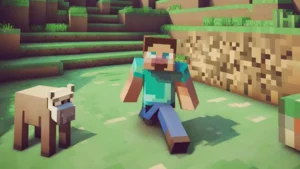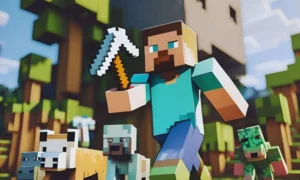Minecraft (2009): Game Icons and Banners
Minecraft, first released to the public in 2009, has become one of the most iconic and influential video games of all time. Developed by Markus “Notch” Persson and later acquired by Mojang Studios and Microsoft, this sandbox game allows players to explore a blocky, procedurally generated world where creativity and survival skills are key. Over the years, Minecraft has evolved in terms of its gameplay mechanics, aesthetics, and customization options.
One of the unique aspects that allow players to leave their mark on the game world is the ability to create banners, which function as a kind of in-game iconography. These banners have become a key visual and creative tool within the Minecraft universe, enabling players to express themselves in ways that transcend basic building mechanics.
In this article, we’ll delve into the world of Minecraft icons and banners, exploring their significance, the process behind creating them, and how they contribute to the game’s overall charm.
The Role of Icons in Minecraft
While Minecraft’s default graphics are simple and stylized, one of the game’s most recognizable elements is its visual identity, including the icons. These icons are seen in various aspects of the game’s interface, such as item icons, achievement badges, and GUI (Graphical User Interface) symbols. Each icon is designed to be easily recognizable in the game’s low-resolution, block-based environment.
- Item Icons: Every block and item in Minecraft has an icon, from dirt blocks to diamond swords. The item icons are key to Minecraft’s inventory system. They provide visual cues that help players organize and manage their materials, tools, and resources. Icons have evolved over the years as the game has added new content. The introduction of new items, from exotic materials like Netherite to whimsical additions like fireworks, has continuously expanded the visual palette of item icons.
- Achievement Icons: The achievement system in Minecraft encourages players to explore different aspects of the game. Each achievement is represented by a small icon that signifies the player’s accomplishment. For example, the icon for the “Diamonds!” achievement depicts a diamond, while the “Taking Inventory” achievement uses a chest icon. These icons serve as both motivational tools and as a record of player progress, providing a sense of completion and mastery over the game’s mechanics.

- Menu and Interface Icons: Minecraft’s simplistic yet effective interface also makes use of icons, from the hearts representing health to the food bar icons that indicate hunger. These icons are crucial for quickly communicating important in-game status to the player without needing to break immersion by overwhelming the player with text. The simplicity of these designs allows for quick recognition and keeps the game’s visual language coherent.
The Significance of Banners in Minecraft
Banners were introduced in Minecraft’s 1.8 update, and they quickly became one of the most beloved customization features in the game. A banner is essentially a tall block that can be decorated with various patterns and colors, allowing players to create flags, signs, or even intricate artwork. These banners can be placed on walls, used as shields, or carried by players to add a personal touch to their armor or base.
- Creative Expression: Banners provide players with a medium for creative expression. Using the in-game crafting system, players can combine dyes and banner patterns to create unique designs. There are limitless possibilities with 16 base colors, over 30 unique patterns, and a layering system that allows for multiple patterns on a single banner. Whether a player wants to create a national flag, a medieval coat of arms, or an abstract design, banners enable this kind of personalization. For many players, the process of designing and crafting a banner is as rewarding as building large-scale structures in Minecraft.
- Practical Applications: Beyond aesthetics, banners serve practical purposes in Minecraft. For instance, players can use banners to mark important locations in their world. By placing banners in specific areas, players can identify the boundaries of their base, mark treasure spots, or even signal pathways for exploration. On multiplayer servers, banners are often used to represent teams, factions, or clans, acting as symbols of identity and unity for groups of players. Players can also combine banners with shields to create custom shields, adding another layer of individuality to their character’s appearance.
- Banner Patterns and Crafting: Crafting banners requires wool and sticks, but what makes banners special is the variety of patterns that can be applied to them. Patterns can be added through a combination of crafting items, dyes, and even special items like the enchanted golden apple (for the Mojang logo pattern). Crafting these patterns is a blend of creativity and resource management, as certain patterns are harder to obtain, giving them prestige within the community. There are also specific banner patterns obtainable via loot or through villagers, adding an element of rarity and achievement.
- Banners in Multiplayer Servers: In multiplayer environments, banners have taken on a life of their own. Many servers have complex systems where banners are used to represent guilds or kingdoms. These banners are often hung in large communal areas or on the walls of fortresses to signify ownership or allegiance. In PvP (Player versus Player) servers, banners can serve as trophies for victories or markers of conquest. They act as both a decorative and functional feature within Minecraft’s social and competitive dynamics.
Minecraft’s Visual Language: Simplicity Meets Depth
The simplicity of Minecraft’s design is part of what makes it so universally appealing. However, beneath that simplicity lies an incredible depth that players can explore. Minecraft’s icons and banners are prime examples of this. On the surface, they are small, functional graphics and decorations, but they become tools for creative storytelling and personal expression. Each item icon reminds players of their goals, each achievement icon marks a milestone in their journey, and each banner is a canvas for imagination.

Minecraft thrives on its community, and icons and banners are yet another way players can connect with each other and the world they inhabit. Whether using banners to mark their territory or designing complex, pixel-art icons for mods, Minecraft players have embraced these tools as essential parts of their experience.
Conclusion
Since its 2009 release, Minecraft has expanded far beyond a simple block-building game into a vast universe of creativity and expression. The game’s icons, from the smallest item in your inventory to the grandest banners flying from fortress walls, play a significant role in shaping the player experience. Through these visual elements, Minecraft provides players with a toolkit to build not just structures, but identity, community, and stories. As the game continues to evolve, one thing remains clear: the power of its icons and banners will always be at the heart of Minecraft’s enduring appeal.